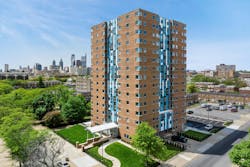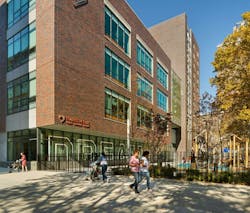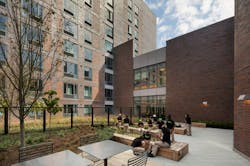3 affordable housing projects that serve as social catalysts
To say the United States is facing an affordable housing crisis is a major understatement. With rents rising across the country, many Americans are living a nightmare. Some teachers in Northern California are living out of their cars, in hovels in the Santa Cruz Mountains, and with multiple roommates in one-bedroom apartments in Daly City, because they can’t afford to pay market-rate rent. And that’s just California. It gets worse.
“Eleven million people in this country are paying more than half of their income for rent, and these are low-income people,” says Richard Burns, CEO of the NHP Foundation, a national not-for-profit provider of affordable housing. “Many of these people are one medical bill or one car breakdown away from being homeless,” Burns adds.
Housing is Fundamental
“Housing is absolutely essential to human flourishing. Without stable shelter, it all falls apart,” Pulitzer Prize-winning sociologist Matthew Desmond told the Chicago Tribune on publication of his book Evicted.
Affordable housing is housing built for people who earn 80% or less of the area median income (AMI). Workforce housing is for people who earn between 80% and 120% of AMI, depending on the market.
With care and forethought, however, visionaries are creating civic-driven affordable and workforce housing that builds inclusive communities, fosters relationships among neighbors, and impacts residents in many positive ways. Perkins Eastman and its specialty studios have been designing such housing across the country for decades.
Yomo Toro Apartments in New York City, Cedar Crossing in Seattle, and Harrison Plaza Senior Tower in Philadelphia are among the examples conceived as more than just a roof overhead. Rather, they’re designed to cultivate a true sense of community.
Among the most important contributions architects and designers can make to help alleviate the affordable housing crisis is to integrate sustainability and resiliency into their designs. Activating underutilized property such as land on school campuses, parking lots, and unused space owned by churches is critical too.
New York City Affordable Housing
1) Yomo Toro Apartments: Top of the Class in Harlem
Perkins Eastman designed the DREAM Charter School and Yomo Toro Apartments, aka the East Harlem Center for Living and Learning, developed by the Jonathan Rose Companies and Harlem RBI, a nonprofit educational organization with deep roots in the community. The goal was to build a charter school and affordable housing and to restore adjacent park space, which together would foster a sense of community. The method was to activate an underutilized site in East Harlem, a parking lot that belonged to the New York City Housing Authority.
The result—a LEED Gold, 143,000-sf, mixed-use complex that opened in 2015—includes a 60,000-sf home for the DREAM Charter School and an 83,000-sf building for the Yomo Toro Apartments. The 88-unit, multifamily affordable housing tower offers studios and one-, two-, and three-bedroom units to people who earn between 40% and 60% of AMI. Offices for Harlem RBI are on the first and second floors of the 11-story residential tower. The K-8 school and tower, which are in the same building with separate entries, have far exceeded expectations.
In a January 2016 New York Times story, “How to Build Affordable Housing in New York City,” Michael Kimmelman wrote, “Serving 486 neighborhood students, DREAM Charter School is the first new public school building in East Harlem in 47 years. ... The school is light-filled, airy, transparent, with big windows opening onto the Washington Houses and rows of trees. Developers also paid for a new 20,000-sf public park to replace a decrepit concrete one that had been on Second Avenue in what’s effectively the school’s front yard.”
The mixed-use development has lifted the entire neighborhood. Since its opening, DREAM students have consistently outperformed their statewide, citywide, and district peers in English language arts and math. As Kimmelman wrote, “In the case of the East Harlem Center, change can bring more than new housing. Neighborhoods need schools and parks, not just apartments, after all. They depend on good planning. That’s what earns public trust.”
Seattle Affordable Housing
2) Cedar Crossing: Community-Oriented Transit in Seattle
Cedar Crossing, a vibrant transit-oriented development (TOD) located steps away from Roosevelt Link Light Rail Station in Seattle, is a transformative project that combines low-cost public transportation with affordable housing. Designed by VIA—A Perkins Eastman Studio—in collaboration with Bellwether Housing and Mercy Housing, two affordable housing developers and owners, Cedar Crossing focuses on families and individuals who earn less than 60% of AMI.
The fact that Sound Transit, the Central Puget Sound Regional Transit Authority, offered the property at a discounted price contributed greatly to making this dream project a reality. Susan Boyd, CEO of Bellwether Housing, describes it as “Seattle’s commitment to an inclusive and just community.” With 254 apartments, including 91 two- and three-bedroom units, Cedar Crossing, which opened last summer, is one of Seattle’s largest 100% affordable housing projects.
Following dozens of community workshops held during the TOD’s planning stages, Sound Transit made a pivotal decision, at the stakeholders’ request, to move Roosevelt Link Light Rail Station, originally planned for a site beneath a nearby freeway, to a central location in the Roosevelt neighborhood—literally next door to Cedar Crossing. With this move, two of the project’s main goals were in sight: walkability and public transit accessibility. A community play area, a daycare, and early learning center that serves 68 students with a bicultural curriculum became part of the community too. Seattle Children’s Hospital and Mary’s Place, serving families with children who have experienced homelessness and have significant medical needs, also help make Cedar Crossing a safe place to live.
The Roosevelt Neighborhood Association and other local stakeholders wanted the site to be traversable and intimately engaged with the community, so a through-block crossing and grand outdoor staircase were designed to connect Cedar Crossing with the surrounding neighborhood. The design activates the perimeter and the interior of the block with retail, community spaces, and a plaza that has proven to be an inviting community draw.
Sustainable elements are woven throughout the overall design, including a rooftop solar array, Energy Star appliances, healthy interior finishes, a high-performance envelope, bike storage for every household, and two electric vehicle charging stations. These features, among others, helped Cedar Crossing meet the Washington State Evergreen Sustainable Development Standards. This thoughtfully planned complex provides affordable housing for more than 500 people.
“The community was so happy to get this completed, they threw an open house, inviting all the new residents, which I thought was a wonderful, gracious gesture on their part,” says VIA Principal Jim Bodoia, the principal in charge and lead designer of Cedar Crossing.
Philadelphia Affordable Housing
3) Harrison Plaza Senior Tower: A Homecoming in Philadelphia
When the Philadelphia Housing Authority (PHA) wanted to transform Harrison Plaza Tower, a 15-story, multifamily high-rise, into 100% affordable housing for seniors, it turned to BLTa to preserve and renovate the architecture and interiors. This meant gutting the tower, making the 116 units (104 one-bedroom and 12 two-bedroom) accessible, and refreshing the exterior dramatically. Milton Lau, lead architect for Harrison Plaza Senior Tower, led the team in giving the building its fresh look: Multicolored metal cladding on the central bay of all four sides of the exterior, repointed brickwork, new windows and insulation, and a new patio that connects to the ground-level community room.
Harrison Plaza now favors residents 55 and older who are at or below 60% of AMI for North Philadelphia. The renovated building features a health-screening room, where doctors and other medical professionals visit periodically and provide basic healthcare to residents, especially those who are mobility challenged. Easy access to mass transportation and City Hall, where many residents seek services, are additional benefits.
Kelvin A. Jeremiah, president and CEO of PHA, is thrilled with the results: “This newly renovated building allows Philly seniors to age well and with dignity. PHA preserved a 67-year-old landmark and, in doing so, transformed an aging tower of public housing in urgent need of costly repairs.” To make this transformation possible, Jeremiah adds, “Low-Income Housing Tax Credits were ... critical to address preservation, development, and redevelopment goals.”
Evelyn Lebron moved into Harrison Plaza in 2011 and was relocated in 2020 for the duration of the renovation. Over the final months before the reopening, she asked staff to take pictures so she could get a sneak peek, but they said they wanted her to be surprised. When she walked in for the reopening, she said, “I wanted to cry, ... but they were happy tears.” Lebron appreciates the rails in the hallways, the grab bars in the bathrooms, and other life-safety features. The security cameras—in the elevator, the mailroom, and the lobby—really caught her eye too.
“We live in a world that is full of anxieties,” Lebron says. “The fact that PHA is making it easier for senior citizens that, in itself, is reason for hope. I hope they continue to build housing like this.” She adds, “I’m going to be A-OK.”
About the Author
Perkins Eastman
Perkins Eastman is a network of more than 1,100 thinkers, dreamers, and doers dedicated to the human experience. While our practice spans sixty countries across five continents, each project is distinctly local—a dynamic structure, space, or solution for people to live, learn, work, play, and heal. Our blog, Insights, is proud to cover the design and innovation that is constantly emerging from our eighteen practice areas and twenty-four interdisciplinary studios worldwide. Find us on LinkedIn, Instagram, Twitter, and Vimeo.




